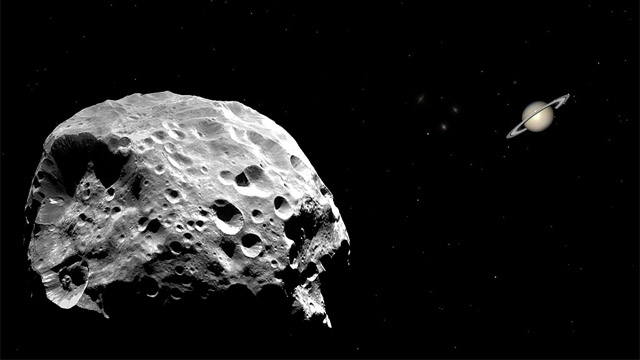
Who's Phoebe? That quirky blonde from Friends? The mysteriously magical nanny from that old sitcom? A bird? A plant? All that--but the one I'm talking about is the moon of Saturn, once thought to be a captured comet, and now believed by some scientists to be something much rarer: a captured planetesimal.
Phoebe: a bit more than 120 miles across—and more potato-shaped than spherical—with a surface gravity approximately 200 times weaker than Earth's (yes, I'd weigh about one pound standing on the surface), Phoebe is not of the stature of its larger, rounder fellow moons of greater fame: Luna, Ganymede, Titan, and the rest.
We've known of Phoebe's existence since 1899, when it was discovered by astronomer W. H. Pickering, and from the start Phoebe was observed to be different from Saturn's "mainline" moons—ones organized into a common orbital plane in close alignment with Saturn's equator, with nice, nearly circular orbits. Phoebe is too much a nonconformist for that; orbiting at a steep, rakish angle from Saturn's equatorial plane, backwards with respect to the conformist crowd, and with great elliptical eccentricity, Phoebe is a fringe radical! And at 30 times the distance from Saturn as our Moon is from Earth, it takes Phoebe longer to orbit Saturn (1.5 years) than Earth does to round the Sun!
All of these peculiarities added up to the hypothesis that Phoebe was not an "indigenous" satellite of Saturn—one that formed with Saturn early in the ages of the solar system—but a solar system object that was captured by Saturn at some point, and since has remained in orbit. And due to its low density (little more than one and a half times as dense as water ice), Phoebe was assumed to be a former comet. Comets passing close to gas giant planets like Saturn are sometimes flung in different directions, sometimes broken up, and sometimes even crash into the planet. But they can also be captured into orbit, as probably many of Jupiter's smaller satellites, and Mars' brood of two, were: former asteroids from the neighboring asteroid belt.
But a comet is a bit of material—ice and rock—left over from the formation of the solar system, about 4.5 billion years ago, pristine and barely altered from its original state. Recently, NASA's Cassini mission has suggested a different origination story for Phoebe, based on imagery and data obtained from our first up-close look at this object by the Cassini spacecraft, in 2004.
